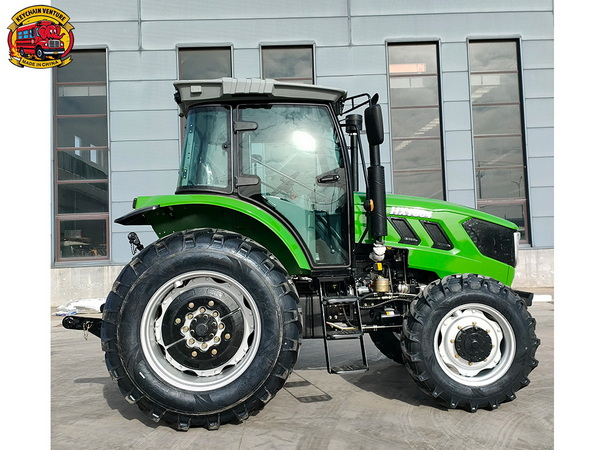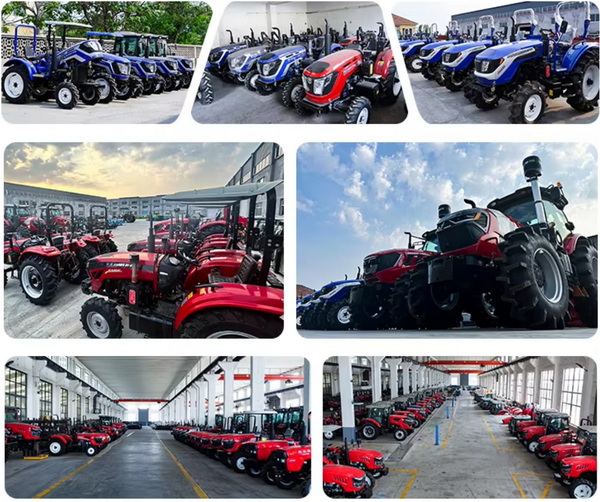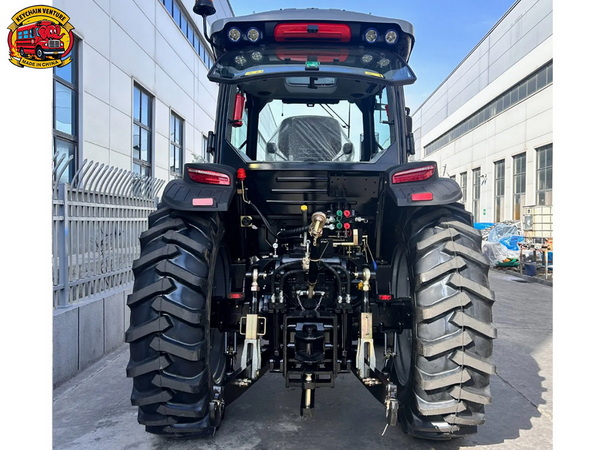Views: 222 Author: Amanda Publish Time: 2025-10-12 Origin: Site








Content Menu
● Understanding Tractor Hours and Their Significance
● Defining What Is a Lot of Hours on a Tractor
● Factors Impacting Tractor Longevity and Hour Reading Relevance
● Exploring Various Tractor Types and Expected Lifespans
>> Heavy-Duty and 4WD Tractors
● Maintenance Best Practices to Extend Tractor Hours
● Understanding the Impact of Usage Intensity
● Comparing Tractor Hours Versus Vehicle Mileage
● High-Performance Tractors and Heavy-Duty Trucks in Commercial Use
● FAQ
>> 1. How many hours on a tractor are considered low usage?
>> 2. Can tractors last over 10,000 hours?
>> 3. Does idling add to tractor hours?
>> 4. What factors influence how long a tractor lasts?
>> 5. Are diesel tractors more durable than gasoline tractors?
Tractors are indispensable machines in agriculture, construction, and commercial hauling. For anyone who owns or operates a tractor, understanding how many hours on a tractor is considered a lot is crucial to making informed purchasing, maintenance, and usage decisions. Tractor usage is measured primarily by engine hours rather than mileage, making the hour meter a key indicator of a tractor's operational lifespan and overall condition.
This article explores the significance of tractor hours, what constitutes high hours, and how various factors influence a tractor's longevity. Additionally, it offers insights into different tractor types, maintenance best practices, and examples of high-performance commercial tractors to give readers a comprehensive understanding of this powerful machinery.

Unlike passenger vehicles, where mileage measures wear and tear, tractors rely on engine hours—how long the engine has run. This includes time spent idling, working, or simply running. Essentially, the hour meter tracks actual engine runtime, giving an accurate sense of the machine's operational use.
This metric is important because tractors often spend long periods running under load, and wear correlates directly with engine activity and operational stress. For instance, two tractors with the same hour reading might differ drastically in condition depending on how those hours were used—whether in light-duty tasks or intense heavy hauling.
Knowing your tractor's hours helps you gauge when service intervals are due, anticipate maintenance needs, and understand resale value.
Categorizing tractor hours into “low,” “average,” or “high” usage depends on many factors, including brand, model, type, and usage intensity. However, rough guidelines can help:
- Tractors with less than 500 hours are typically classified as nearly new with minimal wear.
- Between 500 to 2,000 hours represents moderate use, often mid-life for many machines.
- From 2,000 to 5,000 hours these machines have seen extensive use but can remain reliable with consistent maintenance.
- Beyond 5,000 to 8,000 hours or more is usually considered high hours; tractors in this range may experience more frequent repairs or require overhauls.
- Some heavy-duty tractors, particularly those maintained meticulously, can surpass 10,000 hours with proper care.
Because tractors operate in varied conditions, “high” hours for a lightly used compact tractor will differ significantly from “high” hours for a commercial heavy-duty tractor engineered for continuous operation.
Simply knowing the hours does not show the whole picture. Many variables influence a tractor's real condition and lifespan:
- Maintenance: Diligent upkeep—like oil changes, filter replacements, lubrication, and timely repairs—plays a vital role in extending engine life.
- Usage Type: Operating a tractor in demanding jobs like heavy tilling or hauling naturally accelerates wear compared to light mowing or transport.
- Operating Environment: Extreme weather, dusty or muddy conditions, or exposure to corrosive elements shorten component lifespan.
- Brand and Build Quality: Reputable manufacturers generally design tractors to last longer and perform better over time.
- Storage Conditions: Covering tractors or keeping them in climate-controlled garages prevents rust, degradation, and exposure-based damage.
- Operator Habits: Proper start-up procedures, avoiding excessive idle times, and gentle handling prolong engine and transmission life.
Thus, two tractors with identical hours can differ significantly based on these factors.
Tractors come in many configurations tailored for specific uses. Their lifespans reflect their design and workload:
Small building and landscaping models typically see lifespans between 4,000 and 8,000 hours, depending on tasks and care. They are well-suited for light workloads, gardening, and small-scale farming.
Built for a broader range of farm tasks, utility tractors usually last between 6,000 and 10,000 hours. These versatile machines perform tasks like loading, hauling, and moderate fieldwork.
Used extensively on large farms for heavy fieldwork, these machines can often last 8,000 to 12,000 hours. Their robust design handles long hours of intensive use.
Engineered for the toughest jobs, such as heavy tilling or commercial transport, these tractors may last upwards of 10,000 to 15,000 hours. Their high horsepower and advanced technology allow for prolonged heavy use.
Understanding the typical life expectancy helps in evaluating a tractor's value, especially in buying or selling used equipment.

Routine maintenance is the cornerstone of maximizing tractor lifespan. Ensuring a tractor runs smoothly through thousands of hours requires:
- Regular Oil and Filter Changes: Keeping engine oil clean prevents internal wear and overheating.
- Hydraulic System Care: Monitoring fluid levels and filter conditions protects hydraulic components.
- Tire Maintenance: Proper inflation minimizes vibration and prevents undue stress on axles.
- Lubrication: Greasing joints and bearings regularly reduces wear and tear.
- Air Filter Inspection: Clean air filters maintain engine efficiency.
- Preventive Repairs: Address leaks, worn belts, or minor damages before they escalate.
- Storage: Protect tractors from elements by storing indoors or under covers.
Committing to these steps reduces breakdowns, extends service intervals, and preserves resale value.
Hours alone do not describe how hard a tractor worked. Usage intensity significantly affects wear:
- A hobby farmer using a tractor an hour or two weekly may only add 50-100 hours yearly, leading to slow wear.
- Medium-scale farmers working several hours daily might accumulate 500-1,000 hours annually.
- Commercial operations and construction sites with continuous use may see tractors logging over 2,000 hours yearly.
Higher intensity means more stress, increasing maintenance requirements and likely reducing effective lifespan unless mitigated by superior care.
Understanding the difference between tractor hours and vehicle miles is essential:
- Tractor hours indicate total engine runtime from start to stop, encompassing idling, slow work, and heavy load operation.
- Vehicle mileage counts distance driven, which doesn't necessarily correlate directly with engine use since idling isn't measured.
- A tractor at 2,000 hours might be quite worn, especially if those hours involved hard labor, even if it covered no or few miles.
- Conversely, a light-use tractor might have many hours but little genuine wear if it idled frequently and avoided strain.
This distinction highlights why maintenance and inspection are critical when assessing tractor health.
The term "tractor" also applies to powerful commercial trucks equipped for towing and hauling trailers. These tractors differ from farm tractors but share themes of durability, monitoring engine hours, and longevity.
Examples include:
- Ford Truck Tractor Series: Featuring powerful engines up to 510 PS and advanced fuel efficiency, designed for long-haul logistics.
- MAN TGX 41.680 Individual Lion S: A 680 PS V8 truck with specialized driveline technologies for heavy cargo transport.
- Shacman X5000 Euro 6 T Tractor Truck: Advanced engineering built for demanding transport and construction applications.
These high-performance vehicles exemplify how tractor engineering adapts across industries to provide optimum power while aiming for longevity through technology and maintenance.
The answer to "How many hours on a tractor is a lot?" depends largely on the tractor's type, purpose, maintenance, and operational intensity. While most tractors endure between 4,000 and 15,000 hours, excellent care, moderate use, and quality design can extend service life significantly. Understanding that engine hours represent just one part of the equation helps owners assess true machine health. Proper maintenance, sensible operation, and protecting the tractor from adverse conditions are essential for maximizing the longevity and ROI of this vital equipment.

Generally, less than 500 hours is viewed as low usage, indicating a nearly new tractor with limited wear.
Yes, many heavy-duty tractors exceed 10,000 hours with regular maintenance and reasonable workloads.
Yes, the engine running at any time, including idling, counts toward engine hours.
Maintenance, usage intensity, brand quality, storage conditions, and operator habits significantly affect lifespan.
Diesel tractors are generally more robust and have longer service lives, especially in heavy-duty applications.